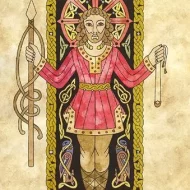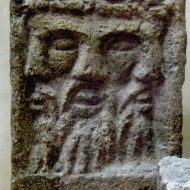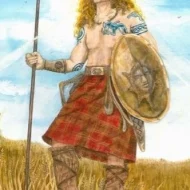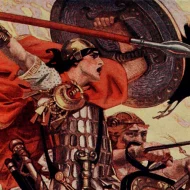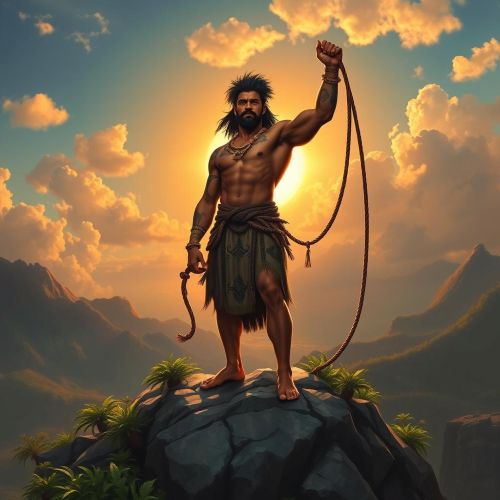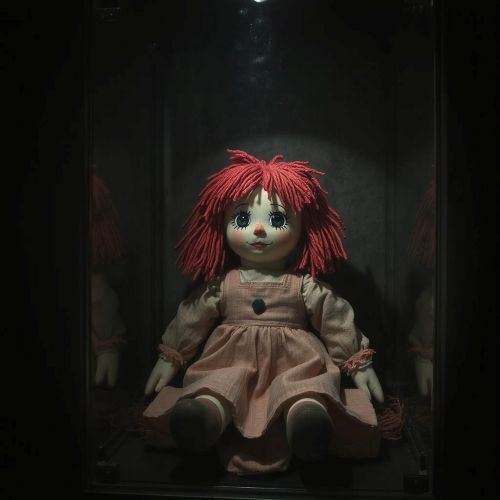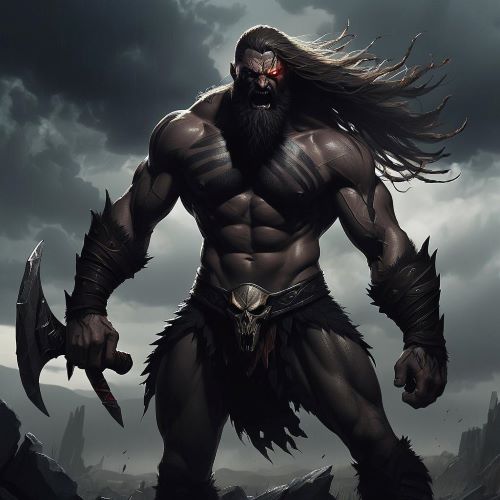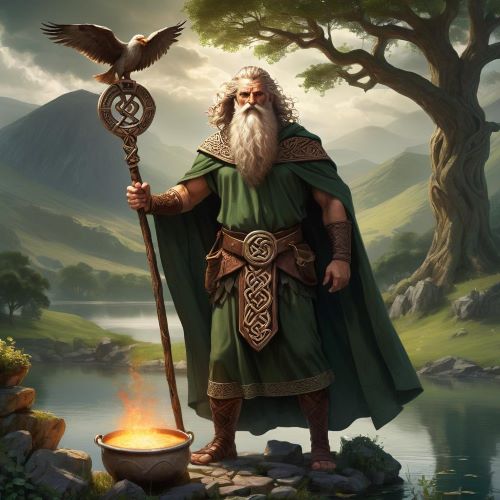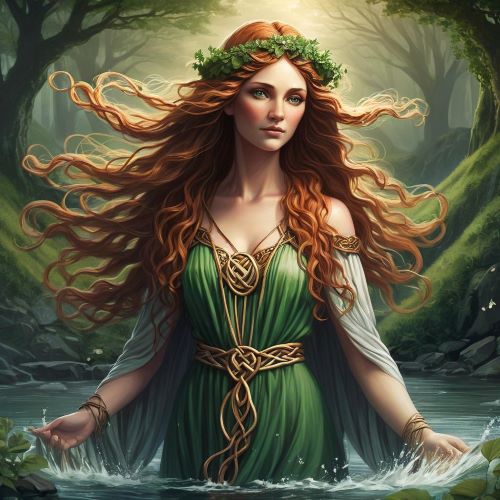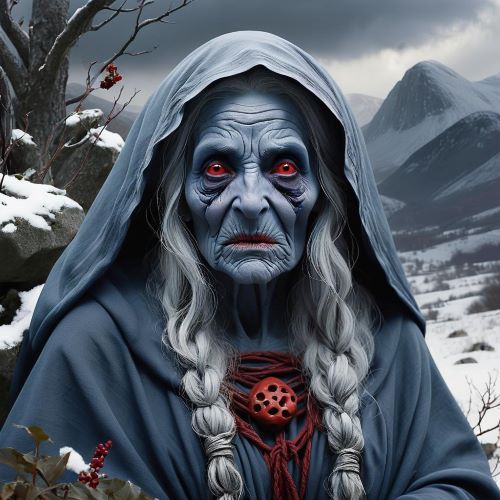Lugh : The God of Skills
Listen
At a glance
| Description | |
|---|---|
| Origin | Irish Mythology |
| Classification | Gods |
| Family Members | Cian (Father), Ethniu (Mother), Buí, Buach, Nás (Wives), Cu Chulainn, Ibic (Sons) |
| Region | Ireland, Scotland, Isle of Mann |
| Associated With | Skills, Light, Justice |
Lugh
Introduction
One of the most significant Celtic deities is Lugh, who was often regarded as a great warrior and cultural hero in Ireland. Although he was initially regarded as an all-seeing god, he later became known for his abilities with throwing weapons and for being skilled in various arts and crafts. Some of the epithets used to describe him include “long-armed” or “of the long hand,” which refer to his ability to throw weapons, and “skilled in many crafts”.
In Irish mythology, Lugh is a prominent figure who led the Tuatha DéDanann to victory at the Battle of the Mag Tuired. He killed Balor using his sling or magic spear, which marked the beginning of a 40-year reign marked by peace and prosperity. Like the Celtic god of Lugus, he is also similar to the mythical creature known as the Gaulish Mercury.
Physical Traits
Lugh is often regarded as a young warrior who was skilled at throwing weapons. In the short narrative Baile in Scail, he is depicted as a beautiful and large horseman and a spear-wielding warrior. He is depicted with a green mantle and a white silver brooch over his breast.
He is depicted wearing a royal satin tunic with a red-gold insertion extending to his knees. He also carries a black shield, which is topped by a hard boss. In his hand, he has a five-pointed spear and a forked javelin.
Family
Irish tradition says that Lug Lamfota, who is also known as Lugus, is the sole surviving member of the three triplet brothers. It is believed that the dedications to him were carried out in three different forms: Lugoues, which are known in Europe, and trinitarian forms. The Celtic affinity for these types of forms suggests that the three gods were also planned for the dedications. According to Irish mythology, the great Ulster hero Cu Chulainn was the son of Lugus.
In Wales, Lleu Gyffes, who was also known as Lleu of the Dexterous Hand, had a strange birth. His mother was Aranrhod, a virgin goddess. She gave birth to a boy child after Math, her uncle, performed a test of her virginity. The boy was immediately adopted by his uncle Gwydion. The cruel Aranrhod tried to destroy her son numerous times, but Gwydion was able to prevent her from doing so. He also made him a woman out of flowers, as his mother refused to grant him a wife.
Other names
In both the Celtic and Irish worlds, Lugh is a popular name. Its meaning has been the subject of debate. It has been argued that the name is derived from the Proto-Indole word lewgh-, which literally means to bind by oath. It has also been linked to the word “light.” However, modern scholars do not believe that this is the case.
His various titles include Lamfada, which literally means “of the long arm,” and Artful Hands, which is a reference to his skill in making things. He was also known as Macnia, Conmac, and Lonnbéimnech.
Lugh was the first chief Ollam, or ruler, of Ireland. This title reflected his abilities as a ruler, poet, and judge. Following his death, the position became a rank-and-file position in the Irish courts. Every kingdom had a Chief Ollam, and each of the High King of Ireland had one.
Powers and Abilities
As the god of oaths, Lugh held the domain over nobles and rulers. He was also regarded as the god of justice, and his quick judgement was often without mercy. In spite of this, he was a trickster, as he was known to steal, lie, and cheat against his enemies. As the child of Fomorians and Tuatha Dé Danann, Lugh inherited a unique heritage. This background allowed him to create various Irish games, such as fidchell and horse-racing.
One of the four jewels of the Tuatha Dé Danann was the Spear of Assal, which can take the form of lightning if thrown. It was an unbeatable weapon during battle. With the word “Ibar,” it hit its mark, and it returned to Lugh. His other weapon, which he used against Balor, was a slingshot known as the cloich tabaill.
The people he forced to answer questions were those he would use his sword to force. Among his various weapons were the Wind-sweeper, which was a boat that could travel at great speeds, and the Flowing Mane, which was a horse that could travel both land and sea. He also had a great dog known as Failinis, who was known for being incredibly skilled at catching his prey.
Modern Day Influence
Lugh continues to be popular in various forms of media. He has appeared in various video games, such as Fire Emblem: Binding Blades. He was also used in the 2004 remake of The Bard’s Tale. In the 90s, Lugh was one of the main characters in the Mystic Knights Of Tir Na Nog, a fantasy series created by Saban.
Throughout the series, various characters have worshipped Lugh. In Marvel Comics, he was regarded as the son of the Dagda, and in Thor: Blood Oath, the Warriors Three and Thor tried to steal the Spear of Assal. In Dungeons & Dragons, Lugh is sometimes referred to as Luggus.
Related Images
Frequently Asked Questions
What was Lugh the god of?
Lugh was a god of the ancient Celts, particularly in Ireland. He was a member of the Tuatha Dé Danann, a group of supernatural beings who were the ancestors and protectors of the Irish people. He was also associated with the sun and fire, and may have been worshipped as a solar deity. He was a master of all crafts, arts, trades and disciplines, including poetry, music, magic, healing, smithing, carpentry, warfare and kingship
What is Lugh known for?
Lugh is known for many things, such as being a god of light and brightness, skill and mastery, thunderstorms and August, kingship and heroism. He is also known for being a member of the Tuatha Dé Danann, a group of supernatural beings who were the ancestors and protectors of the Irish people. He is also known for being the father of Cú Chulainn, the greatest hero of Irish mythology. He is also known for being a master of all crafts, arts, trades and disciplines, including poetry, music, magic, healing, smithing, carpentry, warfare and kingship.
Who was the wife of Lord Lugh?
Lugh had different wives or consorts in different sources and traditions. Some of them are Buí or Bua, a goddess of the Tuatha Dé Danann, Nás or Násad, a goddess of the Tuatha Dé Danann and Deichtine or Dechtire, a mortal princess of Ulster.

